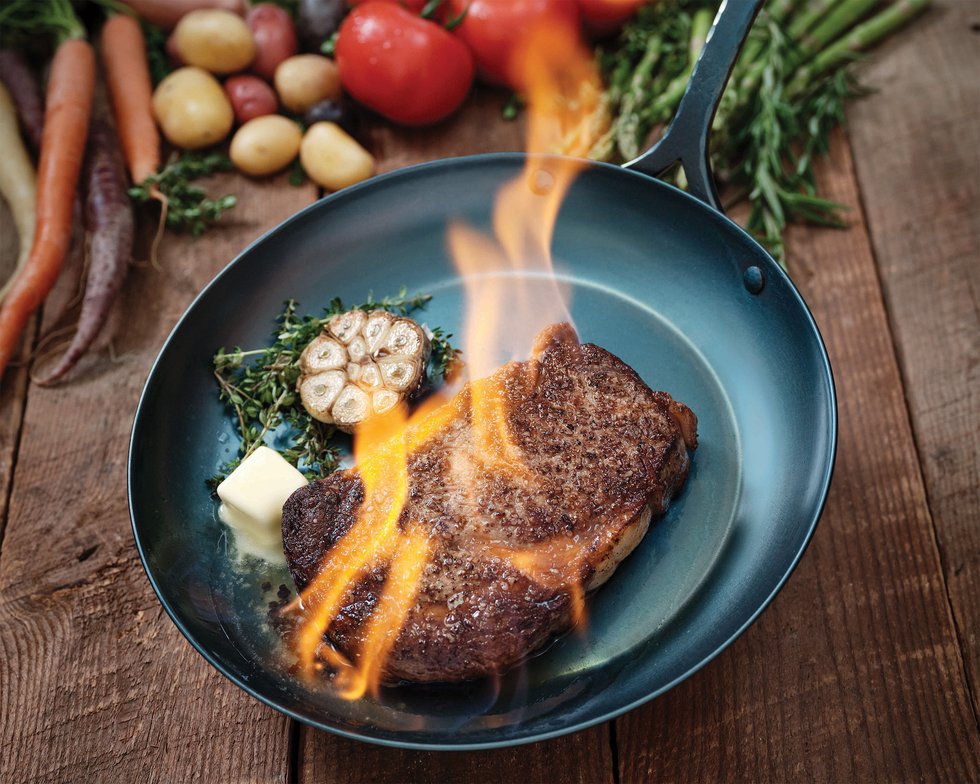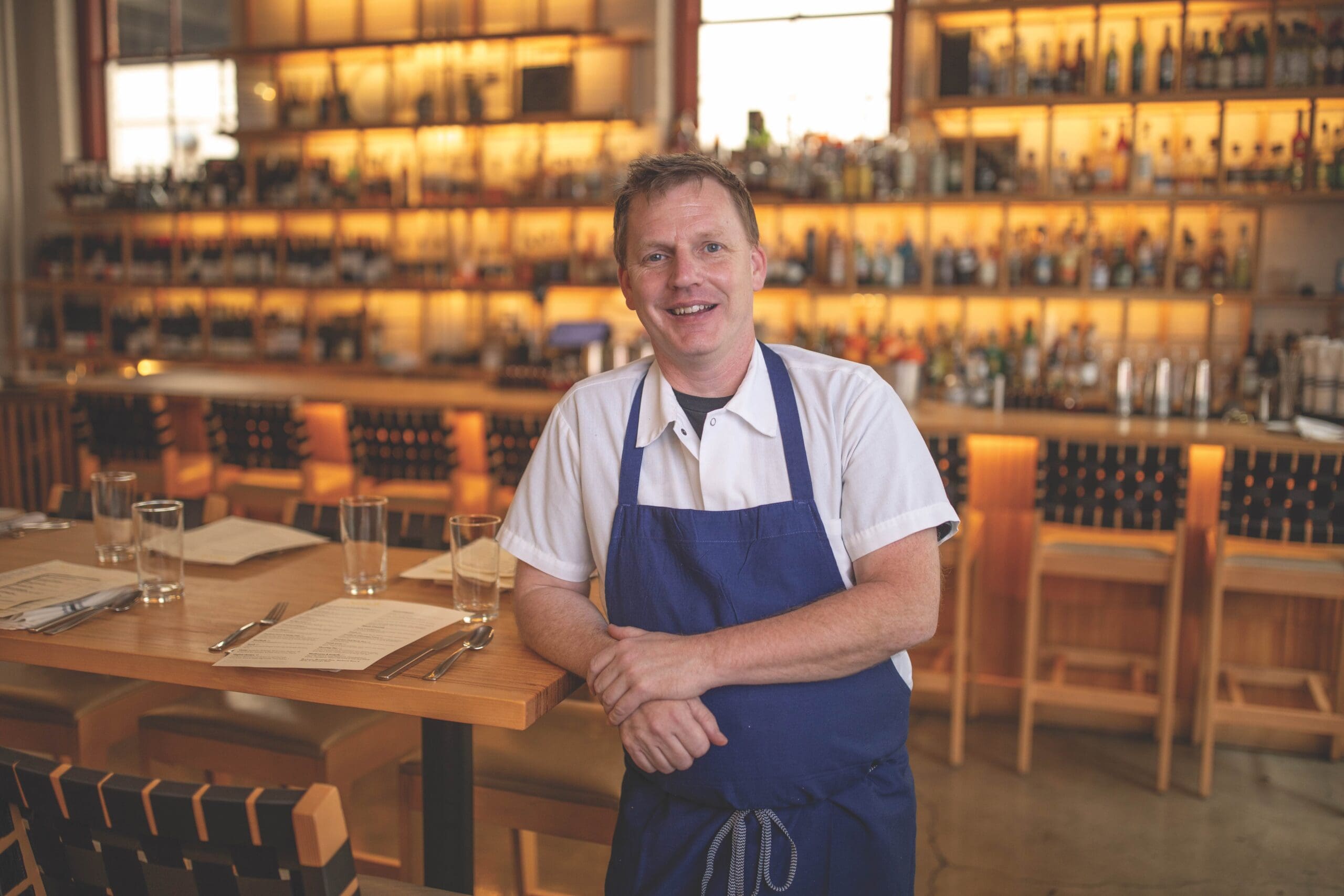Demand is high for Blanc Creatives’ next-gen cookware.

By 2019, Corry Blanc had been pounding out one-of-a-kind, hand-forged carbon steel pans for five years. A meticulous blacksmith, he was constantly improving his design, from the slope of the sidewall to the hammer marks. So later that year, he took to Instagram and began tracing his early days in Charlottesville and the evolution of his carbon steel pans.
Then he let the other shoe drop.
It was time, Blanc said, “to move past hand-forging the pan bases.” For fans of Blanc’s original dimpled pans, the announcement was crushing. The spun-metal bases of his next-generation handcrafted carbon steel cookware—the Pro line—would lack hammer marks. The difference, he insists, is purely aesthetic.
The updated line would look more refined and, he added, “I believe these are our best yet.” After the announcement, chefs lined up to pay $275-$675 for the skillets, sauciers, and roasters from Blanc’s Pro line.

As for his much-loved original hammered pans, Blanc would rename them—the Heritage line—and move them into semi-retirement. The original pans brought national attention in 2015, when they took Overall Winner in Garden & Gun’s Made in the South Awards. Now, whenever Blanc announces a batch of limited-release Heritage pans in his company’s newsletter, they’re snatched up before the digital ink is dry.
Still, he says: “It was a hard decision. We still create each pan right here with our own hands, but spinning the bases makes our products more uniform and consistent, which is what chefs want.” It helps that Blanc Creatives has “no competitors on our scale.” The company, now based in Waynesboro, is also the largest producer of handcrafted carbon steel cookware in the nation.
Keeping Up With Demand
Blanc was broke when the award catapulted him to culinary stardom. “Literally, a nickel was like a million dollars for me. I was making everything using an anvil, hammer, and a coal forge, because that’s what I knew.”
Each Heritage pan takes several hours to hammer. When orders flooded in, it took Blanc and his small team of blacksmiths nine months of hard work to fill them. As articles followed in The Wall Street Journal, GQ, The New York Times, Atlanta Journal-Constitution, and Esquire, Blanc says, “there was no way we could keep up. Repetitive strokes take their toll on blacksmiths. There’s real wear and tear on the employees. After years of doing this, I have nerve damage.”
He moved from Charlottesville to a more spacious facility in Waynesboro. “Just over the mountain,” he says. With modernized production processes in place, Blanc can now offer a consistently superior made-to-order product with shorter wait times.

First Frying Pan
Blanc pulls the first frying pan he ever made out of a display case in his factory’s lobby and compares it to a Pro skillet. The hammered pan, with its riveted handle and shallow, slightly curved edges, looks like a worn antique, the kind chuckwagon cooks might have used. This prototype would propel Blanc into an elite market.
Growing up in north Georgia, he spent summer afternoons with his mother’s parents: racing toy cars in the garage workshop where his grandfather cut and welded metal, or in the kitchen while his grandmother baked. “I associate so much with those smells,” says Blanc. “The aroma of biscuits in the oven is still comforting,” he says. “And hot metal takes me back to being five years old, hugging my grandfather.”
An uncle introduced Blanc to metalwork. “He had a restoration shop, iron railings, and stuff like that,” says Blanc. After working with him for a few years, Blanc left Georgia for Charlottesville in 2007. “I came to visit a girl at UVA and stayed,” he explains.
He took a job with a blacksmith shop in Keswick, where he trained on traditional coal forges. By 2008, when he ventured out on his own, the economy was bottoming out, so he turned to restaurants, “first as a waiter and then in the kitchen,” he says.
The chefs he met talked about their carbon steel pans—the workhorses of professional kitchens. When seasoned properly, carbon steel is essentially nonstick. Lighter than cast iron, the pans transfer easily from stovetop, to oven, to grill, to open flame. But carbon steel pans inevitably warp, bow, and deteriorate under heavy use. Blanc decided to apply his blacksmithing skills to improve their design.

“My first one wasn’t pretty, but I took it to the city market, to gauge interest,” says Blanc. Soon he was handpicking a few trusted local chefs, pressing pans on them to test and asking for their feedback to perfect his prototype.
One of those chefs was Ian Boden, owner of Staunton’s The Shack. “I’ve worked with every brand of black steel pan you can imagine, and there’s a real difference with Corry’s pans,” says the two-time James Beard Award semifinalist. “They’re beautiful and high-quality; just holding one actually inspires you to cook better. Plus, it’s a huge bonus that they are made by really good people right here in Virginia.”
Chefs everywhere are loyal fans, and, naturally, their endorsements inspire home cooks. Food show host and chef Alton Brown is obsessed with Blanc’s 9” skillet, claiming it’s one of the most beautiful pans he’s ever seen. With its lightning-fast heat-up time and hard-to-replicate sear-factor, it’s also been called an absolute Cadillac in the kitchen.
While the change to next-gen pans still triggers angst in some, Boden says it was inevitable and a smart business move. “There are people who still want Corry’s pans to be totally hand-hammered, soup to nuts, and I get that. But when you make a product like this, it’s necessary to have price points that restaurants can afford to meet,” Boden says. “His business has to keep growing. His family and staff depend on him. Things change and improve, and that’s okay.”

A Simmering Future
In Blanc Creatives’ Waynesboro factory, 12 employees now turn out exquisite skillets, roasters, and sauciers, along with a thoughtful list of essentials—from metal skewers and kitchen cleavers, to wooden cocktail muddlers, cutting boards, wooden spoons, bottle openers, even garden trowels. Each handcrafted piece is an object of remarkable beauty, designed to get the job done, only better. Blanc says he’ll add full-time cutlery and ceramics departments, as soon as he finds the right people.
An advocate of trade careers, Blanc says finding skilled workers is his biggest challenge. Fortunately, Waynesboro is also home to the Virginia Institute of Blacksmithing. Several students have come to him for work. Christopher Knox joined the team in 2021 as head of cookware. “I can see my effort in the finished products, which is really satisfying.” he says. “We put so much care into forging the handles, grinding the bases, and assembling and inspecting each piece until everything is just right,” says Knox. “A lot of customers say our pans are too beautiful to keep under the counter, so they hang them on the wall.”
To celebrate its tenth anniversary last year, Blanc threw a party. The food and drink flowed but the big excitement was a fresh batch of hand-forged Heritage pans. “The staff produced about 60 pieces right before Christmas,” says Blanc. “It was a lot of fun—but we were hurting afterwards,” he laughs.


This article originally appeared in the June 2023 issue.









